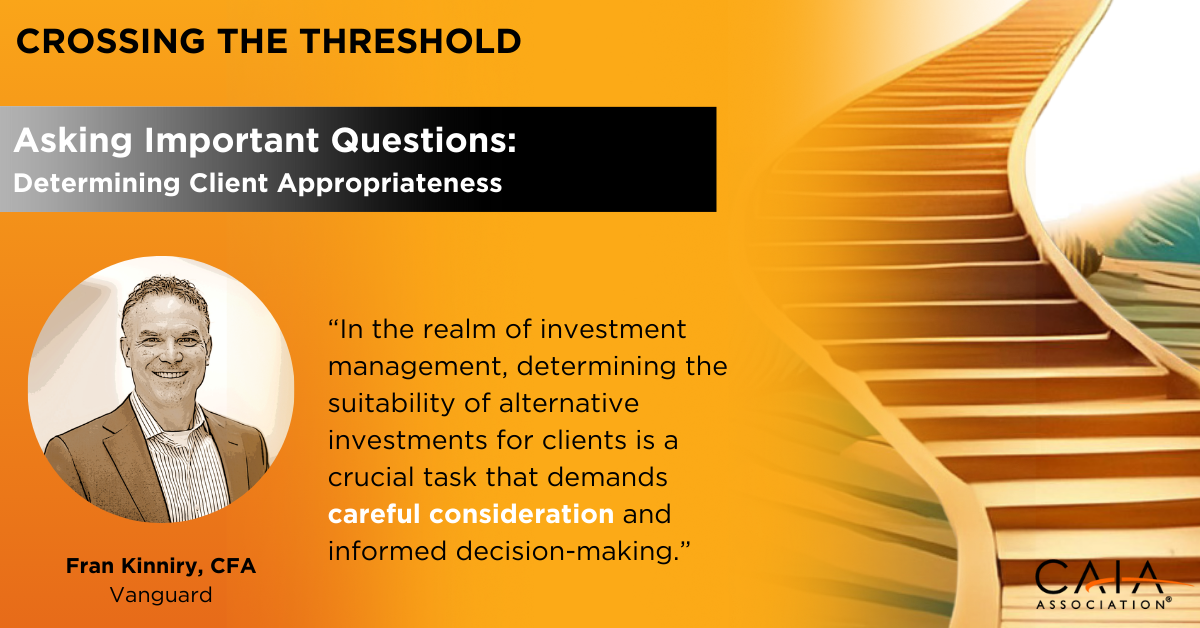By Aaron Filbeck, CAIA, CFA, CFP®, CIPM, FDP, Managing Director, Head of UniFi by CAIA™.
In this blog post, I continue to dissect the recently published report: Crossing the Threshold: Mapping a Journey Towards Alternative Investments in Wealth Management which offers invaluable insights and practical guidance on implementing alternatives effectively. Before diving into the rest of this blog, you can get up to speed by reading the full report or viewing this video.
Stepping beyond the report, I recently had the privilege of engaging in a conversation with Fran Kinniry, Principal and Head of the Vanguard Advisor Research Center and key contributor to the report. He brought a wealth of expertise to our metaphorical journey and advocates for a more holistic approach to determining the appropriateness of integrating alternative investments into client portfolios.
Starting with Self
Within any adventure story, the hero eventually crosses the threshold and stares out into the scary and unfamiliar world, the challenges are far from over. Jumping into the new world may have been exhilarating, but now it’s time to face tests and trials and make friends along the way. Perhaps there is a moment (or several) where they ask themselves, “Why me? Why am I here?”
In wealth management, we often advocate starting with the client and moving backward from there. However, there’s a further extension to this—the client may ultimately be the end investor, but you, as the fiduciary, are the crucial decision-maker on their behalf. Before you can even begin to think about integration, it’s vital to assess your own internal capabilities and whether you can offer these strategies to clients in the first place.
Fran provided a balanced perspective on the benefits of integrating alternatives into portfolios but also highlights the additional complexities involved. As someone who led the charge to introduce private equity to Vanguard’s Personal Advisor Services clients (who historically were used to long-only, low-cost, public markets), Fran brings a wealth of knowledge and experience to this subject. As he highlights in the report and further in our conversation, several factors can impact an advisor’s ability to provide suitable advice and management around alternatives, including capacity, competency, information access, investment options, and regulations. All of these should be addressed before moving forward.
However, once you’ve done the work on the front end of the decision-making process, and you’re ready to invest, it’s important to stay the course, diversify within your alternative investment programs, and view this as a long-term investment rather than a vehicle for market-timing (as illustrated in Figure 1, albeit with private equity only). For newcomers, this is especially important when ramping up allocations over several years (if they go the traditional drawdown fund structure path) or shorter (if they pursue semi-liquid fund structures or a combination of both).
Figure 1: Staying the course with private equity commitments

Source: “Potential in persistence: Staying the course with private equity investments.” Vanguard. April 2023.
The Path Ahead
Reflecting on our conversation, I found myself particularly interested in the nuances of where and how the wealth management community should embark on its journey—a glimpse into the foundational steps that often remain behind the curtain. Fran, like myself, doesn’t believe that the proverbial 60/40 portfolio is dead— it’s merely one type of allocation. While it’s not appropriate for every single investor, he points out that, while you may be able to enhance client outcomes by adding other investments, the 60/40 has done just fine over long periods of time. If you’re going to do more, do it right!
About the Author:
Aaron Filbeck, CAIA, CFA, CFP®, CIPM, FDP oversees UniFi by CAIA™, a learning platform dedicated to educating the private wealth management industry on alternative investments. He was previously responsible for leading and implementing CAIA Association's content agenda, thought leadership initiatives, and content development for the CAIA Charter Program.

Aaron is a frequent speaker and writer on various topics of alternative investments and his work has been published in CAIA’s educational programs, numerous academic journals, books, and industry publications. Aaron’s industry experience lies in private wealth management, where he oversaw asset allocation, portfolio construction, and manager research efforts for high-net-worth individuals and institutional retirement plans.
He earned a B.S. with distinction in Finance and a Master of Finance from Penn State University. He holds the Chartered Alternative Investment Analyst (CAIA), Chartered Financial Analyst (CFA), Certificate in Investment Performance Measurement (CIPM), and Financial Data Professional (FDP) designations, and is a CERTIFIED FINANCIAL PLANNER™. He is a Past President of CFA Society Columbus and serves as a board director and Programs Chair for CFA Society Philadelphia. Aaron is an adjunct professor and serves on multiple advisory boards for Penn State University.




